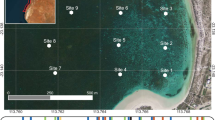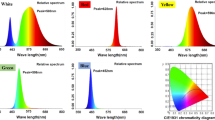Abstract
Two species of giant clams, Tridacna maxima and T. squamosa, coexist in the Red Sea, but exhibit distinctly different depth distributions: T. maxima mostly occurs in shallow waters (reef flat and edge), while T. squamosa may occur down to the lower fore-reef slope. Giant clams have been described as mixotrophic, capable of both filter-feeding and photosynthesis due to algal symbionts (zooxanthellae), therefore, observed depth preferences were investigated in relation to possible differences in autotrophy vs. heterotrophy. This study was conducted from April to June 2004, at the reef near the Marine Science Station, Aqaba, Gulf of Aqaba, Red Sea, and in May 2007, at a reef near Dahab, Sinai Peninsula, Egypt. In situ measurements using a submersible pulse amplitude modulated fluorometer (Diving PAM), revealed no significant differences in effective PSII quantum yield (ΔF/Fm′) and relative electron transport rates (ETR) between the two species; but rapid light curves (ETR vs. light, photosynthetically active irradiance, PAR) showed significant differences in maximum photosynthetic rates (ETRmax), with 20% higher values in T. maxima. Chamber incubations displayed higher net and gross oxygen production by T. maxima (88.0 and 120.3 μmol O2 cm−2 mantle area day−1) than T. squamosa (56.7 and 84.8 μmol O2 cm−2 mantle area day−1); even under shading conditions (simulated depth of 20 m) T. maxima still achieved 93% of the surface gross O2 production, whereas T. squamosa reached only 44%. A correlation was found between ETR and net photosynthesis measured as oxygen production (T. maxima: R 2 = 0.53; T. squamosa: R 2 = 0.61). Calculated compensation depth (CD) (gross photosynthesis equals respiration) in T. maxima (16 m) matches the maximum depth of occurrence in this study (17 m). By contrast, the CD of T. squamosa (9 m) was much shallower than the maximum vertical range (42 m). Findings suggest T. maxima is a strict functional photoautotroph limited by light, whereas T. squamosa is a mixotroph whose photoautotrophic range is extended by heterotrophy.







Similar content being viewed by others
References
Ambariyanto, Hoegh-Guldberg O (1997) Effect of nutrient enrichment in the field on the biomass, growth and calcification of the giant clam Tridacna maxima. Mar Biol (Berl) 129:635–642. doi:10.1007/s002270050206
Baillie BK, Monje V, Silvestre V, Sison M, Belda-Baillie CA (1998) Allozyme electrophoresis as a tool for distinguishing different zooxanthellae symbiotic with giant clams. Proc R Soc Lond B Biol Sci 265:1949–1956. doi:10.1098/rspb.1998.0525
Beckvar N (1981) Cultivation, spawning and growth of the giant clams Tridacna gigas, Tridacna derasa and Tridacna squamosa in Palau, Caroline Islands. Aquaculture 24:21–30. doi:10.1016/0044-8486(81)90040-5
Beer S, Ilan M, Eshel A, Weil A, Brickner I (1998) Use of pulse amplitude modulated (PAM) fluorometry for in situ measurements of photosynthesis in two faviid corals. Mar Biol 131:607–612. doi:10.1007/s002270050352
Belda CA, Lucas JS, Yellowlees D (1993) Nutrient limitation in the giant-clam symbiosis: effects of nutrient supplements on growth of the symbiotic partners. Mar Biol (Berl) 117:655–664. doi:10.1007/BF00349778
Belda-Baillie CA, Sison M, Silvestre V, Villamor K, Monje V, Gomez ED et al (1999) Evidence for changing symbiotic algae in juvenile tridacnids. J Exp Mar Biol Ecol 241:207–221. doi:10.1016/S0022-0981(99)00079-9
Fisher CR, Fitt WK, Trench RK (1985) Photosynthesis and respiration in Tridacna gigas as a function of irradiance and size. Biol Bull 169:230–245. doi:10.2307/1541400
Fitt WK, Cook CB (2001) Photoacclimation and the effect of the symbiotic environment on the photosynthetic response of symbiotic dinoflagellates in the tropical marine hydroid Myrionema amboinense. J Exp Mar Biol Ecol 256:15–31. doi:10.1016/S0022-0981(00)00302-6
Gorbunov MY, Kolber ZS, Lesser MP, Falkowski PG (2001) Photosynthesis and photoprotection in symbiotic corals. Limnol Oceanogr 46:75–85
Griffiths DJ, Klumpp DW (1996) Relationships between size, mantle area and zooxanthellae numbers in five species of giant clam (Tridacnidae). Mar Ecol Prog Ser 137:139–147. doi:10.3354/meps137139
Griffiths DJ, Winsor H, Luong-Van T (1992) Iridophores in the mantle of giant clams. Aust J Zool 40:319–326. doi:10.1071/ZO9920319
Hawkins AJS, Klumpp DW (1995) Nutrition of the giant clam Tridacna gigas (L.) II. Relative contribution of filter feeding and the ammonium acquired and recycled by symbiotic algae towards total nitrogen requirements for tissue growth and metabolism. J Exp Mar Biol Ecol 190:263–290. doi:10.1016/0022-0981(95)00044-R
Iglesias-Prieto R, Trench RK (1994) Acclimation and adaptation to irradiance in symbiotic dinoflagellates. I Responses of the photosynthetic unit to changes in photon flux. J Exp Mar Biol Ecol 113:163–175
Ishikura M, Kato C, Maruyama T (1997) UV-absorbing substances in zooxanthellate and azooxanthellate clams. Mar Biol (Berl) 128:649–655. doi:10.1007/s002270050131
Jeffrey SW, Haxo FT (1967) Photosynthetic pigments of symbiotic dinoflagellates (zooxanthellae) from corals and clams. Biol Bull 135:149–165. doi:10.2307/1539622
Jeffrey SW, Mantoura RFC, Bjørnland T (1997) Data for the identification of 47 key phytoplankton pigments. In: Jeffrey SW, Mantoura RFC, Wright SW (eds) Phytoplankton pigments in oceanography, guidelines to modern methods, vol 10. UNESCO Publishing, Paris, pp 449–559
Klumpp DW, Griffiths CL (1994) Contribution of phototrophic and heterotrophic nutrition to the metabolic and growth requirements of four species of giant clam (Tridacnidae). Mar Ecol Prog Ser 115:103–115. doi:10.3354/meps115103
Klumpp DW, Lucas JS (1994) Nutritional ecology of the giant clam Tridacna tevoroa and T. derasa from Tonga: influence of light on filter-feeding and photosynthesis. Mar Ecol Prog Ser 107:147–156. doi:10.3354/meps107147
Klumpp DW, Bayne BL, Hawkins AJS (1992) Nutrition of the giant clam Tridacna gigas (L.). I Contribution of filter feeding and photosynthates to respiration and growth. J Exp Mar Biol Ecol 155:105–122. doi:10.1016/0022-0981(92)90030-E
Lesser MP (2000) Depth dependent photoacclimatization to solar ultraviolet radiation in the Caribbean coral Montastraea faveolata. Mar Ecol Prog Ser 192:137–151. doi:10.3354/meps192137
Lesser MP, Gorbunov MY (2001) Diurnal and bathymetric changes in chlorophyll fluorescence yields of reef corals measured in situ with a fast repetition rate fluorometer. Mar Ecol Prog Ser 212:69–77. doi:10.3354/meps212069
Mangum CP, Johansen K (1982) The influence of symbiotic dinoflagellates on respiratory processes in the giant clam Tridacna squamosa. Pac Sci 36:395–400
Manu N, Sone S (1995) Breeding season of the Tongan shellfish. 3. Elongated giant clam, Tridacna maxima. Fish Res Bull Tonga 3:25–33
Mobley KB, Gleason DF (2003) The effect of light and heterotrophy on the carotenoid concentrations in the Caribbean anemone Aiptasia pallida (Verrill). Mar Biol (Berl) 43:629–638. doi:10.1007/s00227-003-1123-7
Muscatine L (1990) The role of symbiotic algae in carbon and energy flux in reef corals. In: Dubinsky Z (ed) Coral reefs. Elsevier, Amsterdam
Muscatine L, Porter JW (1977) Reef corals: mutualistic symbiosis adapted to nutrient-poor environments. Biomed Sci 27:454–460
Norton JH, Shepherd MA, Long HM, Fitt WK (1992) The zooxanthellae tubular system in the giant clam. Biol Bull 183:503–506. doi:10.2307/1542028
Ralph PJ, Gademann R, Larkum AWD, Schreiber U (1999) In situ underwater measurements of photosynthetic activity of coral zooxanthellae and other reef-dwelling dinoflagellate endosymbionts. Mar Ecol Prog Ser 180:139–147. doi:10.3354/meps180139
Roa-Quiaoit H, Richter C (in review) Distribution, abundance, size and growth of giant clams (Tridacnidae) in the Northern Gulf of Aqaba, Red Sea
Roa-Quiaoit H, Richter C, Zibdeh M (2004) Towards a sustainable aquaculture of giant clams (Tridacnidae) in the Jordanian sector of the Gulf of Aqaba. In: Sixth international aquarium congress, Monterey Bay Aquarium, Monterey, CA, USA, 5–10 December 2004
Schreiber U (1986) Detection of rapid induction kinetics with a new type of high-frequency modulated chlorophyll fluorometer. Photosynth Res 9:261–272. doi:10.1007/BF00029749
Shick JM, Lesser MP, Dunlap WC, Stochaj WR, Chalker BE, Won JW (1995) Depth-dependent responses to solar ultraviolet radiation and oxidative stress in the zooxanthellate coral Acropora microphthalma. Mar Biol (Berl) 122:41–51. doi:10.1007/BF00349276
Sims N, Howard N (1988) Indigenous tridacnid clam populations and introduction of Tridacna derasa in the Cook Islands. In: Copland J, Lucas J (eds) Giant clams in Asia and the Pacific. ACIAR Monograph No. 9, ACIAR, Canberra, pp 34–40
Streamer M, Griffiths DJ, Thinh L (1988) The products of photosynthesis by zooxanthellae (Symbiodinium microadriaticum) of Tridacna gigas and their transfer to the host. Symbiosis 6:237–252
Titlyanov EA, Titlyanova TV, Yamazato K, van Woesik R (2001) Photo-acclimation dynamics of the coral Stylophora pistillata to low and extremely low light. J Exp Mar Biol Ecol 263:211–225. doi:10.1016/S0022-0981(01)00309-4
Trench RK (1979) Cell biology of plant-animal symbiosis. Annu Rev Plant Physiol Plant Mol Biol 30:485–531
Trench RK, Wethey DS, Porter JW (1981) Observations on the Symbiosis with zooxanthellae among the Tridacnidae (Mollusca, Bivalvia). Biol Bull 161:180–198. doi:10.2307/1541117
Warner ME, Chilcoat GC, McFarland FK, Fitt WK (2002) Seasonal fluctuations in the photosynthetic capacity of photosystem II in symbiotic dinoflagellates in the Caribbean reef-building coral Montastrea. Mar Biol (Berl) 141:31–38. doi:10.1007/s00227-002-0807-8
Wild C, Tollrian R, Huettel M (2004) Rapid recycling of coral mass-spawning products in permeable reef sediments. Mar Ecol Prog Ser 271:159–166. doi:10.3354/meps271159
Winkler LW (1888) The determination of dissolved oxygen in water. Ber Dtsch Chem Ges 21:2843–2857. doi:10.1002/cber.188802102122
Wright SW, Jeffrey SW (1997) High-resolution HPLC system for chlorophylls and carotenoids of marine phytoplankton. In: Jeffrey SW, Mantoura RFC, Wright SW (eds) Phytoplankton pigments in oceanography, guidelines to modern methods. UNESCO Publishing, Paris
Acknowledgements
This study was funded by the German Ministry for Education and research (grant no. 03F0356A). Thanks are due to the scientific and technical staff of the MSS, in particular to Mohammed Rasheed, Yousef Ahmed and Abdullah Al-Momany (diving supervision) for support. Thanks to Matthias Birkicht and Stefani Bröhl for technical advice and logistics at the ZMT. Special thanks to Ralph Tollrian for supporting this study, especially the part in Dahab. Thanks to the MPI, notably Dirk deBeer and Raphaela Schoon for HPLC access and assistance.
Author information
Authors and Affiliations
Corresponding author
Additional information
Communicated by J.P. Grassle.
Electronic supplementary material
Below is the link to the electronic supplementary material.
Rights and permissions
About this article
Cite this article
Jantzen, C., Wild, C., El-Zibdah, M. et al. Photosynthetic performance of giant clams, Tridacna maxima and T. squamosa, Red Sea. Mar Biol 155, 211–221 (2008). https://doi.org/10.1007/s00227-008-1019-7
Received:
Accepted:
Published:
Issue Date:
DOI: https://doi.org/10.1007/s00227-008-1019-7




